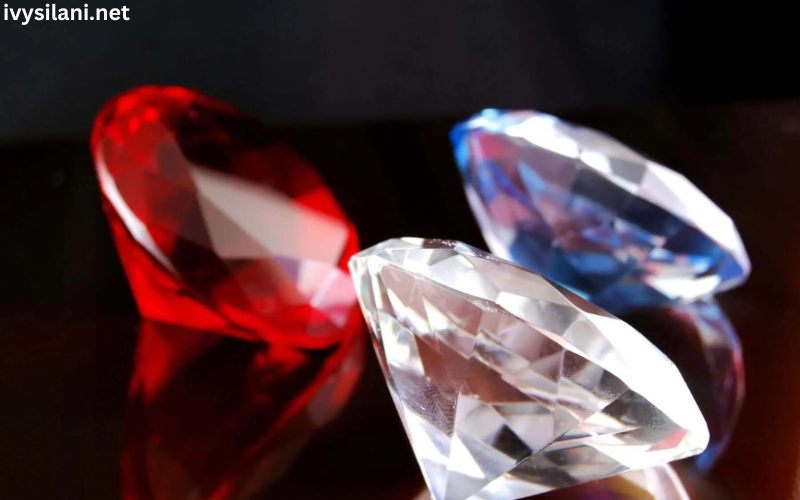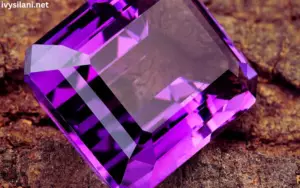Lifestyle
Unveiling the Top Natural Diamond Alternatives: A Comprehensive Guide

When it comes to choosing a gemstone for your engagement ring or jewelry, natural diamonds have long been the traditional choice. Top Natural Diamond Alternative. However, there is a growing trend among consumers to explore alternative options that offer similar beauty and sparkle without the ethical and environmental concerns associated with mining natural diamonds. In this comprehensive guide, we will delve into the world of natural diamond alternatives, exploring their benefits, types, and factors to consider when choosing the right one for you.
Why Consider Natural Diamond Alternatives?
There are several reasons why you might consider natural diamond alternatives. One of the primary reasons is the ethical concern surrounding the diamond industry. Natural diamonds are often associated with unethical mining practices, including child labor and environmental damage. By choosing a natural diamond alternative, you can be confident that your purchase is not contributing to these issues.
Another reason to consider natural diamond alternatives is the cost. Natural diamonds can be quite expensive, especially those with high clarity and carat weight. Opting for a natural diamond alternative can provide you with a more affordable option while still having a beautiful and durable gemstone.

Types of Natural Diamond Alternatives
There are several types of natural diamond alternatives available in the market. Let’s explore some of the most popular ones:
Moissanite: The Top Natural Diamond Alternative
Moissanite is a gemstone that closely resembles a natural diamond in appearance. It is known for its exceptional brilliance and fire, which means it reflects light beautifully, creating an eye-catching sparkle. Moissanite is also highly durable, making it suitable for everyday wear. Additionally, moissanite is more affordable than natural diamonds, allowing you to get a larger stone for your budget.
Lab-Grown Diamonds: The Eco-Friendly Choice
Lab-grown diamonds, also known as cultured or synthetic diamonds, are created in a laboratory environment using advanced technology that replicates the natural diamond formation process. These diamonds have the same physical and chemical properties as natural diamonds, making them virtually indistinguishable. Lab-grown diamonds are considered an eco-friendly choice as they have a significantly lower carbon footprint compared to mined diamonds.
White Sapphires: A Durable and Affordable Alternative
White sapphires are another natural diamond alternative that offers a similar appearance. While they may not have the same level of brilliance as diamonds or moissanite, white sapphires can still exhibit a beautiful sparkle. They are highly durable and can withstand everyday wear. One of the advantages of white sapphires is their affordability, allowing you to stay within your budget without compromising on the beauty of your jewelry.
Cubic Zirconia: The Most Affordable Alternative
Cubic zirconia is a synthetic gemstone that closely resembles a diamond. It is known for its affordability, making it an excellent choice for those on a tight budget. While cubic zirconia may not have the same level of durability as moissanite or lab-grown diamonds, it still offers a remarkable sparkle and can be a great option for occasional wear or as a temporary solution.
Comparing Natural Diamond Alternatives: Durability, Brilliance, and Cost
When choosing a natural diamond alternative, several factors should be considered. Durability, brilliance, and cost are three crucial aspects to evaluate.
In terms of durability, moissanite, lab-grown diamonds, and white sapphires are all highly durable and suitable for everyday wear. Cubic zirconia, on the other hand, is less durable and may be prone to scratching and damage over time.
In terms of brilliance, moissanite is known for its exceptional sparkle, closely resembling that of a natural diamond. Lab-grown diamonds and white sapphires also offer a beautiful sparkle, although they may have slight differences in fire and brilliance. Cubic zirconia, while affordable, may not have the same level of brilliance as the other alternatives.
When it comes to cost, cubic zirconia is the most affordable option, followed by white sapphires, moissanite, and lab-grown diamonds. Each alternative offers a range of price points, allowing you to find one that suits your budget.
How to Choose the Right Natural Diamond Alternative for You
Choosing the right natural diamond alternative depends on your personal preferences and priorities. Consider factors such as budget, durability, brilliance, and overall aesthetic appeal. If you value eco-friendliness, lab-grown diamonds may be the ideal choice for you. If you prioritize affordability, cubic zirconia or white sapphires may be more suitable. Ultimately, take the time to research and compare different options to find the perfect natural diamond alternative that aligns with your needs and values.
Caring for and Maintaining Natural Diamond Alternatives
Proper care and maintenance are essential to ensure the longevity and beauty of your natural diamond alternative. While these alternatives are durable, they still require regular cleaning and protection. Avoid exposing them to harsh chemicals or abrasive materials, and store them separately to prevent scratches. Regularly clean your gemstone using a mild soap solution and a soft brush. If in doubt, consult a professional jeweler for specific care instructions tailored to your chosen natural diamond alternative.
Where to Buy Natural Diamond Alternatives
There are several reputable sources where you can purchase natural diamond alternatives. Online retailers specializing in alternative gemstones offer a wide range of options and competitive prices. Be sure to read reviews and verify the authenticity and quality of the gemstones before making a purchase. You can also explore local jewelers who may have a selection of natural diamond alternatives or be able to source them for you. Remember to ask for certifications or guarantees to ensure the authenticity and quality of your chosen gemstone.
The Future of Natural Diamond Alternatives
As consumer awareness and demand for ethical and eco-friendly alternatives continue to grow, the future of natural diamond alternatives looks promising. Advances in technology and production methods will likely result in even more options and improvements in the quality and affordability of these alternatives. It is an exciting time for those seeking beautiful and sustainable alternatives to traditional natural diamonds.
Conclusion
When it comes to choosing a gemstone, natural diamond alternatives offer a range of options that can meet your desires for beauty, durability, and ethical considerations. Whether you opt for moissanite, lab-grown diamonds, white sapphires, or cubic zirconia, each natural diamond alternative has its unique characteristics and benefits. By understanding the different types, comparing their durability, brilliance, and cost, and considering your personal preferences, you can make an informed decision and find the perfect natural diamond alternative for your jewelry. Embrace the future of sustainability and style with these exquisite alternatives to traditional natural diamonds.
CTA: Discover the beauty and sustainability of natural diamond alternatives today. Shop our collection and find the perfect gemstone for your jewelry.
Lifestyle
Uncover the Hidden Gems of San Antonio: Discover the Top Destinations for Memorable Outings and Adventures

San Antonio, a city rich in history and culture, offers a unique blend of adventure, entertainment, and relaxation. Located in the heart of Texas, this vibrant city has something to offer for everyone. Whether you are an outdoor enthusiast, a food lover, or a history buff, San Antonio has numerous hidden gems waiting to be discovered. So pack your bags and get ready to explore the top destinations for memorable outings and adventures in this captivating city.
The Rich History of San Antonio
San Antonio’s history dates back to the early 18th century when Spanish explorers settled in the region. One of the most iconic landmarks in San Antonio is the Alamo, a former mission turned fortress that played a significant role in the Texas Revolution. Step back in time as you explore the Alamo and learn about its historical significance. Another must-visit historical site is the San Antonio Missions National Historical Park, which preserves four Spanish colonial missions, including Mission San Jose and Mission Concepcion. Immerse yourself in the rich history of San Antonio as you wander through these ancient sites.
Top Outdoor Destinations in San Antonio for Adventure Seekers
If you’re an adventure seeker, San Antonio won’t disappoint. Head to the Natural Bridge Caverns, a vast underground cave system filled with stunning rock formations. Take a guided tour and marvel at the beauty of these natural wonders. For a thrilling outdoor experience, visit the Six Flags Fiesta Texas amusement park. With its exhilarating roller coasters and water rides, this park guarantees an adrenaline rush like no other. And for a unique adventure, explore the San Antonio River Walk, a scenic pathway along the San Antonio River. Rent a kayak or paddleboard and discover the city from a different perspective.

Explore the Vibrant Cultural Scene in San Antonio
San Antonio is a melting pot of cultures, and its vibrant arts scene is a testament to this diversity. Visit the San Antonio Museum of Art and explore its vast collection of artworks spanning thousands of years. From ancient Egyptian artifacts to contemporary masterpieces, this museum has something to captivate every art enthusiast. Another cultural gem is the Tobin Center for the Performing Arts, where you can catch world-class performances ranging from ballet to Broadway shows. Immerse yourself in the cultural richness of San Antonio and be inspired by its artistic offerings.
Hidden Gems for Food Lovers in San Antonio
San Antonio is a food lover’s paradise, offering a blend of traditional Tex-Mex cuisine and innovative culinary creations. For a taste of authentic Mexican flavors, visit the Market Square, also known as El Mercado. Indulge in mouthwatering tacos, enchiladas, and tamales while immersing yourself in the vibrant atmosphere of this bustling marketplace. If you’re in the mood for something unique, head to the Pearl District, a vibrant culinary and cultural destination. Here, you’ll find a variety of restaurants serving delectable dishes crafted from locally sourced ingredients. Treat your taste buds to an unforgettable culinary experience in San Antonio.
Family-Friendly Destinations in San Antonio
San Antonio is a perfect destination for a family getaway, with numerous attractions that cater to all ages. Take your family to the San Antonio Zoo, where you can encounter a wide variety of animals from around the world. Don’t miss the opportunity to visit SeaWorld San Antonio, where you can witness captivating marine life shows and embark on thrilling rides. For a day of fun and learning, head to the Witte Museum, which offers interactive exhibits on science, history, and natural resources. Create lifelong memories with your family as you explore the family-friendly destinations in San Antonio.
Must-Visit Landmarks and Attractions in San Antonio
In addition to its rich history, San Antonio is home to several iconic landmarks and attractions that should not be missed. The Tower of the Americas, standing at 750 feet tall, offers breathtaking panoramic views of the city. Take a ride to the top and marvel at the spectacular scenery below. Another must-visit site is the San Antonio Botanical Garden, a lush oasis filled with exotic plants and tranquil gardens. Stroll through the beautifully landscaped grounds and immerse yourself in nature’s beauty. And no visit to San Antonio is complete without a leisurely boat ride along the San Antonio River Walk. Admire the picturesque scenery and enjoy the vibrant atmosphere of this iconic destination.

Best Shopping Spots in San Antonio
If you’re a shopaholic, San Antonio has no shortage of retail therapy options. The Shops at La Cantera is a premier shopping destination, offering a mix of high-end boutiques and popular retailers. Explore the stylish stores and indulge in a shopping spree. For a unique shopping experience, head to the Historic Market Square, where you can find a wide range of Mexican crafts, artwork, and souvenirs. Immerse yourself in the vibrant atmosphere and take home a piece of San Antonio’s culture. And if you’re looking for a bargain, visit the San Antonio Rivercenter Mall, a three-level shopping center with a variety of stores and dining options.
Unwind and Relax at San Antonio’s Parks and Gardens
After a day of exploring, take some time to unwind and relax in San Antonio’s beautiful parks and gardens. The Japanese Tea Garden, nestled within Brackenridge Park, offers a serene escape from the bustling city. Take a leisurely stroll through the lush gardens and admire the tranquil ponds and cascading waterfalls. Another peaceful oasis is the San Antonio Botanical Garden, where you can find quiet corners to relax and rejuvenate. Grab a book and find a shady spot under a tree, or simply soak in the beauty of your surroundings. San Antonio’s parks and gardens provide the perfect backdrop for relaxation and reflection.
Conclusion: Plan Your Next Adventure in San Antonio
San Antonio is a city filled with hidden gems waiting to be discovered. From its rich history to its vibrant cultural scene, there is something for everyone in this captivating city. Whether you’re an adventure seeker, a food lover, or a history buff, San Antonio has it all. So, plan your next adventure and uncover the hidden gems of San Antonio for a memorable outing that will leave you wanting more.
CTA: Book your trip to San Antonio today and embark on an unforgettable journey of exploration and adventure.
Lifestyle
Unveiling the Courage Within: Inspiring Stories of Resilience in the Face of Congenital Heart Conditions

Congenital heart conditions are a complex and often misunderstood group of medical conditions that affect individuals from birth. These conditions, which involve abnormalities in the structure or function of the heart, can present a wide range of challenges for both the individual and their family. Understanding the intricacies of these conditions is crucial in order to provide the necessary support and resources for those affected. Face of Congenital Heart Conditions.
Congenital heart conditions encompass a variety of specific diagnoses, each with its own unique set of challenges. Some individuals may have conditions that are relatively mild and manageable, while others may require extensive medical intervention and lifelong care. Regardless of the severity, living with a congenital heart condition requires resilience, determination, and a strong support system.
The impact of congenital heart conditions on individuals and families
The impact of a congenital heart condition extends far beyond the individual affected. Families often face emotional, financial, and logistical challenges as they navigate the complexities of managing their loved one’s condition. The constant worry, medical appointments, and potential for unexpected complications can take a toll on everyone involved.
Parents of children with congenital heart conditions often experience a wide range of emotions, from fear and anxiety to hope and determination. They become advocates for their child’s health, diligently researching treatment options, and connecting with other families facing similar challenges. Siblings may also struggle with the emotional impact of having a brother or sister with a congenital heart condition, feeling both protective and overwhelmed by the responsibilities that come with it.
Born brave: Inspiring stories of resilience
Despite the challenges they face, individuals with congenital heart conditions often demonstrate remarkable resilience and courage. From a young age, they learn to adapt to their unique circumstances, often facing multiple surgeries and medical interventions with remarkable bravery.
One such inspiring story is that of Sarah, who was born with a complex congenital heart condition. Throughout her life, she has undergone numerous surgeries and faced countless obstacles. Despite these challenges, she has never let her condition define her. Sarah has become an advocate for others with congenital heart conditions, using her story to raise awareness and provide support to those who need it.

Overcoming challenges: Physical and emotional journeys
Living with a congenital heart condition requires individuals to navigate both physical and emotional challenges. Physically, they may face limitations in terms of exercise and physical activity, as well as the need for regular medical monitoring and interventions. Emotionally, they may grapple with feelings of fear, anxiety, and frustration as they navigate their unique health journey.
Support systems and resources play a crucial role in helping individuals with congenital heart conditions overcome these challenges. Support groups, both online and in-person, provide a sense of community and understanding. Medical professionals specializing in congenital heart conditions offer expertise and guidance. Access to mental health resources is also essential, as individuals may experience heightened levels of stress and anxiety.
Support systems and resources for individuals with congenital heart conditions
Individuals with congenital heart conditions thrive when they have a strong support system in place. This support can come from family, friends, medical professionals, and the wider community. It is essential for individuals to have a network of people who understand their unique needs and can provide emotional support and guidance.
In addition to personal support networks, there are numerous resources available to individuals with congenital heart conditions. Non-profit organizations, such as the American Heart Association and the Adult Congenital Heart Association, offer a wealth of information and support. These organizations provide educational materials, connect individuals with medical professionals, and advocate for policy changes to improve the lives of those with congenital heart conditions.
Advocacy and raising awareness for congenital heart conditions
Advocacy and raising awareness are crucial components of improving the lives of individuals with congenital heart conditions. By sharing personal stories and educating the public, individuals and organizations can help break down stigmas and misconceptions surrounding these conditions.
Raising awareness can take many forms, from participating in advocacy events and fundraisers to sharing stories on social media platforms. By shining a light on the experiences of individuals with congenital heart conditions, we can foster understanding, empathy, and support.
Medical advancements and treatment options
Over the years, medical advancements have revolutionized the treatment options available for individuals with congenital heart conditions. Surgical techniques have become more advanced, allowing for safer and more effective interventions. Medications have been developed to manage symptoms and improve quality of life.
In addition to traditional treatment options, research into regenerative medicine and stem cell therapy offers hope for the future. These emerging technologies have the potential to repair damaged heart tissue and improve overall heart function. While still in the early stages, these advancements hold promise for individuals with congenital heart conditions.

Living a fulfilling life with a congenital heart condition
Despite the challenges they face, individuals with congenital heart conditions can live fulfilling and meaningful lives. With the right support, resources, and mindset, they can pursue their passions, achieve their goals, and find joy in everyday moments.
Self-care and mental well-being play crucial roles in maintaining a fulfilling life with a congenital heart condition. Engaging in activities that bring joy and practicing stress management techniques are important for overall well-being. Regular check-ups and open communication with medical professionals ensure that individuals receive the necessary care and support to live their best lives.
Promoting self-care and mental well-being
Promoting self-care and mental well-being is essential for individuals with congenital heart conditions. It is important for individuals to prioritize their physical and emotional well-being, as this directly impacts their ability to manage their condition effectively.
Engaging in regular exercise, eating a balanced diet, and getting enough rest are all important aspects of physical self-care. Mental well-being can be supported through practices such as mindfulness, therapy, and connecting with support networks. By prioritizing self-care, individuals can better navigate the challenges of living with a congenital heart condition.
Conclusion
Living with a congenital heart condition requires immense courage, resilience, and support. Understanding the impact of these conditions on individuals and families is crucial in providing the necessary resources and support systems. By sharing inspiring stories of resilience, advocating for awareness, and promoting self-care, we can help individuals with congenital heart conditions live fulfilling lives and overcome the challenges they face. Together, we can unveil the courage within and inspire others to face their own obstacles with strength and determination.
CTA: If you or someone you know is living with a congenital heart condition, remember that you are not alone. Reach out to support networks, connect with medical professionals, and prioritize your physical and mental well-being. With the right support and resources, you can live a fulfilling life and inspire others with your resilience.
Lifestyle
How to Choose the Perfect Watch for Your Lifestyle

Choosing the right watch is not just about telling time; Choose the Perfect Watch for Your Lifestyle, it is about making a statement and reflecting your personal style. Whether you are an adventurer, a fitness enthusiast, or a fashion-forward individual, finding the perfect watch that suits your lifestyle is essential. In this article, we will explore the factors to consider when choosing a watch, the different types of watches available for different lifestyles, how to match your watch to your personal style, popular watch brands and their specialties, where to buy watches, tips for maintaining and caring for your watch, and how to budget for a watch purchase. By the end of this guide, you will be equipped with the knowledge to select the ideal timepiece that complements your lifestyle.
The Importance of Choosing the Right Watch
A watch is more than just a timekeeping device; it is a reflection of your personality and the way you live your life. When you wear a watch that suits your lifestyle, it becomes an extension of yourself, making a statement about who you are and what you value. Whether you are a professional who needs a watch that exudes elegance and sophistication, an athlete who requires a watch that can withstand rigorous activities, or a fashion-conscious individual who wants a watch that complements your style, choosing the right watch is crucial.
Factors to Consider When Choosing a Watch
Selecting the perfect watch involves considering several factors that align with your needs and preferences. First, you need to determine the primary function you expect from your watch. Do you need a watch primarily for timekeeping, or are you looking for additional features like chronograph, date display, or a specific complication? Once you have identified the primary function, you can narrow down your options.
Next, consider the type of movement you prefer. Mechanical watches are known for their craftsmanship and intricate movements, while quartz watches are more accurate and require less maintenance. Decide whether you prioritize the traditional charm of a mechanical watch or the practicality of a quartz watch.
Additionally, think about the size and weight of the watch. A watch that is too big or too heavy can be uncomfortable to wear, while a watch that is too small may not make the desired impact. Try on different watches to find the perfect fit for your wrist.
Determining Your Lifestyle and Watch Needs
Understanding your lifestyle is crucial when selecting a watch that can withstand the demands of your daily activities. Consider the environments you frequently find yourself in. Are you an avid traveler who needs a watch with multiple time zones? Are you a diver who requires a watch with water resistance? By assessing your lifestyle and watch needs, you can narrow down the choices to watches that are suitable for your specific requirements.
If you lead an active lifestyle and engage in sports or outdoor activities, consider a sports watch that offers durability, water resistance, and additional features such as a chronograph or a compass. On the other hand, if you primarily wear a watch for formal or business occasions, a dress watch with a minimalist design and a leather or metal strap may be more appropriate.
Different Types of Watches for Different Lifestyles
When it comes to choosing a watch that matches your lifestyle, there are various types to consider. Let’s explore some of the most popular watch styles and their suitability for different lifestyles:
Sports Watches
Sports watches are designed to withstand rigorous activities and offer features like water resistance, shock resistance, and durability. These watches are perfect for athletes, adventurers, and individuals who engage in outdoor activities. They often come with features such as a chronograph, a tachymeter, or a compass to enhance their functionality.
Dress Watches
Dress watches are elegant and sophisticated, designed to complement formal attire or business wear. They are typically slim, with a minimalist dial and a leather or metal strap. Dress watches are suitable for individuals who attend formal events or work in professional settings.
Dive Watches
Dive watches are specifically designed for underwater use and offer high water resistance. They often feature a unidirectional rotating bezel, luminous hands and markers, and a robust construction to withstand the pressures of diving. Dive watches are ideal for divers or individuals who enjoy water sports.
Aviator Watches
Aviator watches, also known as pilot watches, were originally designed for pilots and feature large, easy-to-read dials and luminous hands for enhanced visibility. They often have additional features like a slide rule or a GMT function to assist with navigation. Aviator watches are suitable for frequent travelers or individuals who appreciate the aviation aesthetic.
Fashion Watches
Fashion watches prioritize style and trends, often featuring bold designs, vibrant colors, and unconventional materials. They are ideal for fashion-forward individuals who want their watch to make a fashion statement.

Matching Your Watch to Your Personal Style
Your watch is an expression of your personal style, and it should complement your overall look. Consider your wardrobe, preferred colors, and the occasions you will be wearing the watch for. If you have a classic and timeless style, a watch with a simple and elegant design, such as a stainless steel case and a black leather strap, will be a versatile choice. For a more casual and contemporary look, a watch with a colorful dial or a fabric strap can add a pop of personality to your outfit.
Additionally, think about the materials and finishes that align with your style. Stainless steel watches offer a sleek and modern look, while gold or rose gold watches exude luxury and sophistication. Leather straps provide a classic and refined touch, while rubber or fabric straps offer a sporty and casual vibe.
Popular Watch Brands and Their Specialties
When it comes to choosing a watch, understanding the reputation and specialties of popular watch brands can help you make an informed decision. Here are some renowned watch brands and their areas of expertise:
Rolex
Rolex is synonymous with luxury and precision. Known for their impeccable craftsmanship, Rolex watches are highly sought after for their timeless designs and exceptional quality. Rolex offers a wide range of watches, from sports models like the Submariner to elegant dress watches like the Datejust.
Omega
Omega is a Swiss brand known for its association with space exploration and James Bond movies. Omega watches are renowned for their accuracy, durability, and innovative features. The Speedmaster, known as the “Moonwatch,” was the first watch worn on the moon.
TAG Heuer
TAG Heuer combines sportiness with Swiss craftsmanship. The brand is known for its chronographs and has a strong presence in the world of motorsports. TAG Heuer watches offer a blend of performance and style, making them a popular choice for sports enthusiasts.
Patek Philippe
Patek Philippe is revered for its exquisite timepieces and superior complications. The brand is known for its exceptional craftsmanship and timeless elegance. Patek Philippe watches are often considered investment pieces due to their high value and collectability.
Casio
Casio is a Japanese brand that offers a wide range of affordable watches with innovative features. They are known for their digital watches, especially the G-Shock line, which is renowned for its durability and shock resistance. Casio watches are popular among outdoor enthusiasts and individuals who require a rugged timepiece.

Where to Buy Watches and How to Spot a Fake
When purchasing a watch, it is essential to buy from reputable sources to ensure authenticity and quality. Here are some reliable places to buy watches:
Authorized Retailers
Buying from authorized retailers guarantees that you are purchasing a genuine watch. Authorized retailers have direct partnerships with watch brands and offer warranties and after-sales support. Visit the brand’s official website to find a list of authorized retailers near you.
Online Retailers
Online retailers like Amazon, eBay, and specialized watch websites offer a wide selection of watches. However, exercise caution and buy from trusted sellers with positive reviews. Look for detailed product descriptions, high-resolution images, and customer feedback to make an informed purchase.
Second-Hand Market
The second-hand market can be a great way to find unique or discontinued watches at a more affordable price. Platforms like Chrono24 and Watchfinder specialize in pre-owned watches and provide authentication services to ensure the authenticity of the timepiece.
To spot a fake watch, pay attention to the details. Counterfeit watches often have poor craftsmanship, misspellings, and inaccuracies in the logo or engravings. Research the specific watch model and compare it to authentic images to identify any discrepancies. If a deal seems too good to be true, it is likely a counterfeit.
Tips for Maintaining and Caring for Your Watch
Once you have chosen the perfect watch, it is important to maintain and care for it to ensure its longevity. Here are some tips to keep your watch in optimal condition:
Regular Cleaning
Clean your watch regularly to remove dirt, sweat, and oils that can accumulate on the case and strap. Use a soft cloth or a brush with mild soap and water to gently clean the watch. Avoid using harsh chemicals or abrasive materials that can damage the watch’s finish.
Service and Maintenance
Mechanical watches require periodic servicing to maintain their accuracy. It is recommended to have your watch serviced by a professional watchmaker every three to five years. Quartz watches generally require less maintenance but may still benefit from a battery replacement and a check-up every few years.
Storage
When not wearing your watch, store it in a watch box or a soft pouch to protect it from dust, moisture, and scratches. Avoid exposing your watch to extreme temperatures, magnetic fields, or direct sunlight, as these can affect its performance.
Water Resistance
If your watch is water-resistant, ensure that the crown is properly screwed down or pushed in before exposing it to water. Follow the manufacturer’s guidelines regarding water resistance and avoid wearing a water-resistant watch while engaging in activities like swimming or diving unless it is specifically designed for such use.
Budgeting for a Watch Purchase
Setting a budget is essential when purchasing a watch to avoid overspending. Determine how much you are willing to invest in a watch based on your financial situation and the value you place on owning a timepiece. Consider factors like brand reputation, materials, complications, and exclusivity when assessing the price range that aligns with your budget.
Research the average prices of watches in your desired category and compare prices from different retailers to ensure you are getting the best value for your money. Keep in mind that while luxury watches can be expensive, they often retain their value or even appreciate over time, making them potential investment pieces.
Conclusion
Choosing the perfect watch for your lifestyle is a decision that should not be taken lightly. By considering factors such as your lifestyle, watch needs, personal style, and budget, you can make an informed choice that reflects your individuality. Whether you opt for a sports watch, a dress watch, or a fashion-forward timepiece, remember that your watch is a statement piece that tells the world who you are and what you value. Take your time, explore different options, and find the watch that not only keeps time but also resonates with your soul. Happy watch hunting!
-

 Entertainment1 year ago
Entertainment1 year agoMarvel Executive Producer Discusses the MCU’s Recent Struggles
-

 Entertainment1 year ago
Entertainment1 year agoiVysilani: A Comprehensive Guide to Your Favorite Streaming Platform
-

 Entertainment1 year ago
Entertainment1 year agoThe 1982 Movie Poltergeist Used Real Skeletons As – Tymoff
-

 Biography1 year ago
Biography1 year agoHeyimbee | Biography, Age, Wiki, Height, Net Worth, Relationship, Facts, Family, Education
-

 Biography1 year ago
Biography1 year agoJules Ari | Biography, Age, Wiki, Height, Net Worth, Relationship, Facts, Family, Education
-

 Biography1 year ago
Biography1 year agomissmiafit | Biography, Age, Wiki, Height, Net Worth, Relationship, Facts, Family, Education
-

 Biography1 year ago
Biography1 year agoJoeBen Bevirt | Biography, Age, Wiki, Height, Net Worth, Relationship, Facts, Family, Education
-

 Biography1 year ago
Biography1 year agoJellybeanbrains | Biography, Age, Wiki, Height, Net Worth, Relationship, Facts, Family, Education




Jung Schiesher
June 8, 2025 at 7:52 pm
Your comment is awaiting moderation.
I saw a lot of website but I conceive this one holds something special in it in it